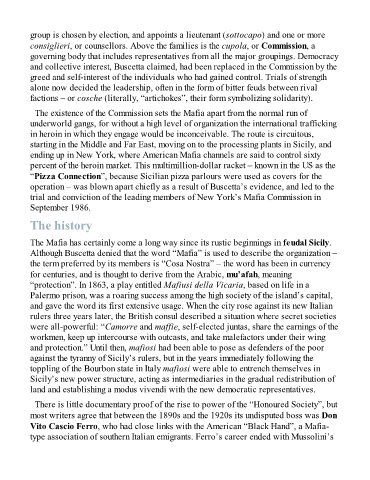Page 577 - The Rough Guide of Sicily
P. 577
group is chosen by election, and appoints a lieutenant (sottocapo) and one or more
consiglieri, or counsellors. Above the families is the cupola, or Commission, a
governing body that includes representatives from all the major groupings. Democracy
and collective interest, Buscetta claimed, had been replaced in the Commission by the
greed and self-interest of the individuals who had gained control. Trials of strength
alone now decided the leadership, often in the form of bitter feuds between rival
factions – or cosche (literally, “artichokes”, their form symbolizing solidarity).
The existence of the Commission sets the Mafia apart from the normal run of
underworld gangs, for without a high level of organization the international trafficking
in heroin in which they engage would be inconceivable. The route is circuitous,
starting in the Middle and Far East, moving on to the processing plants in Sicily, and
ending up in New York, where American Mafia channels are said to control sixty
percent of the heroin market. This multimillion-dollar racket – known in the US as the
“Pizza Connection”, because Sicilian pizza parlours were used as covers for the
operation – was blown apart chiefly as a result of Buscetta’s evidence, and led to the
trial and conviction of the leading members of New York’s Mafia Commission in
September 1986.
The history
The Mafia has certainly come a long way since its rustic beginnings in feudal Sicily.
Although Buscetta denied that the word “Mafia” is used to describe the organization –
the term preferred by its members is “Cosa Nostra” – the word has been in currency
for centuries, and is thought to derive from the Arabic, mu’afah, meaning
“protection”. In 1863, a play entitled Mafiusi della Vicaria, based on life in a
Palermo prison, was a roaring success among the high society of the island’s capital,
and gave the word its first extensive usage. When the city rose against its new Italian
rulers three years later, the British consul described a situation where secret societies
were all-powerful: “Camorre and maffie, self-elected juntas, share the earnings of the
workmen, keep up intercourse with outcasts, and take malefactors under their wing
and protection.” Until then, mafiosi had been able to pose as defenders of the poor
against the tyranny of Sicily’s rulers, but in the years immediately following the
toppling of the Bourbon state in Italy mafiosi were able to entrench themselves in
Sicily’s new power structure, acting as intermediaries in the gradual redistribution of
land and establishing a modus vivendi with the new democratic representatives.
There is little documentary proof of the rise to power of the “Honoured Society”, but
most writers agree that between the 1890s and the 1920s its undisputed boss was Don
Vito Cascio Ferro, who had close links with the American “Black Hand”, a Mafia-
type association of southern Italian emigrants. Ferro’s career ended with Mussolini’s

